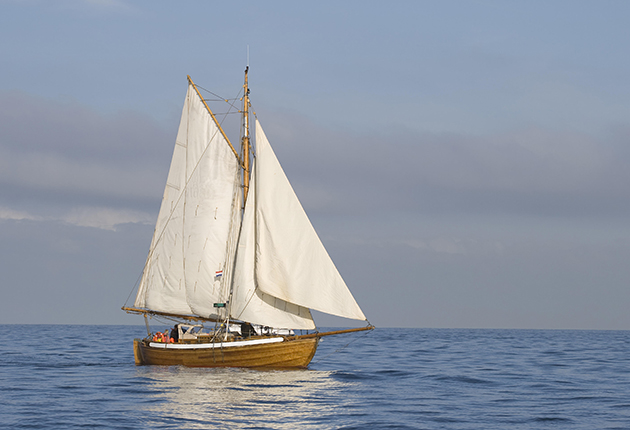How would you get a 56ft yacht into a tight berth with no working bow thruster and on a flood tide? James Stevens answers your Questions of Seamanship
Could you berth with no bow thruster?
James Stevens answers your Questions of Seamanship.
Question:
Peter received a generous golden handshake when he left his job and planned to circumnavigate the globe.
After much deliberation and research he decided that Equilibrium, a Farr 56, was the one for him.
It is a production sloop with a fin keel.
Unfortunately, the pandemic scuppered his circumnavigation plans so he is confined to the UK, and the only long-term berth available is the end berth on an inside pontoon in his home marina.
The outer pontoon is not attached to the shore, but because his draught is 3.3m he can only approach from the gap adjacent to his berth.
Approaching from the other end of the outer pontoon is too shallow.

Credit: Maxine Heath
Peter is quite an experienced yachtsman and has taken the RYA courses up to Coastal Skipper practical.
He usually finds Equilibrium is a handful in the marina, and even more difficult today as the bow thruster is faulty.
He has been out for a couple of days cruising and it is time to face the problem of berthing.
On arrival, the tide is flooding at over half a knot and the wind blowing off the pontoon at about 12 knots.
There are yachts all round including one further along the pontoon from his berth.
Once secured, the gap between Equilibrium and the next yacht is about 4m.
How does Peter get alongside?
Answer:
This his is a tricky manoeuvre on a flood tide. It would be easier on the ebb, but that would mean a difficult exit.
The problem is that if Peter enters starboard side-to, the tide and wind will take the stern away from the pontoon and at worst the yacht would drift down sideways onto the other yachts.
On the other hand, attempting to enter astern means that the bow could be caught by the wind and tide.
The answer is to enter astern into the gap between the pontoons and then motor forward into the berth against the tidal stream.
Continues below…
How do I get out of a severe broach?
If your boat was about to broach what would you do? James Stevens answers your Questions of Seamanship
Should you push on with a tired boat crew?
With a tidal stream against you and a tired boat crew, should you push on or turn around? James Stevens…
How do you offset making too much leeway?
You are making leeway in your Sweden 390. What can you do to correct your course? James Stevens answers your…
Could you get out of this tight berth?
Would you know how to manoeuvre a 22.5m vessel out of a tight berth? James Stevens answers your questions of…
Before attempting this manoeuvre it is important to know how the boat will handle astern.

James Stevens, author of the Yachtmaster Handbook, spent 10 of his 23 years at the RYA as Training Manager and Yachtmaster Chief Examiner
Peter should practice steering astern in clear water, finding out what happens when changing from ahead to astern.
On the approach to the berth, engage astern early, clear of the pontoons and ensure there is steerage, but avoid excessive speed.
When steering into the gap between the pontoons it is important to stay safely up tide of the downtide pontoon.
Take the power off for the last boat length or so.
Once the bow has passed the centre point of the home berth, engage ahead with a burst of power, enough to stop the yacht and propel it slowly forward.
At the same time steer carefully into the berth, ensuring the stream does not push the boat in too soon causing the stern to hit the yacht behind.
If Peter is unable to handle this manoeuvre I would suggest some boat-handling tuition.
Enjoyed reading Could you berth with no bow thruster?
A subscription to Yachting Monthly magazine costs around 40% less than the cover price.
Print and digital editions are available through Magazines Direct – where you can also find the latest deals.
YM is packed with information to help you get the most from your time on the water.
-
-
- Take your seamanship to the next level with tips, advice and skills from our experts
- Impartial in-depth reviews of the latest yachts and equipment
- Cruising guides to help you reach those dream destinations
-
Follow us on Facebook, Twitter and Instagram.








